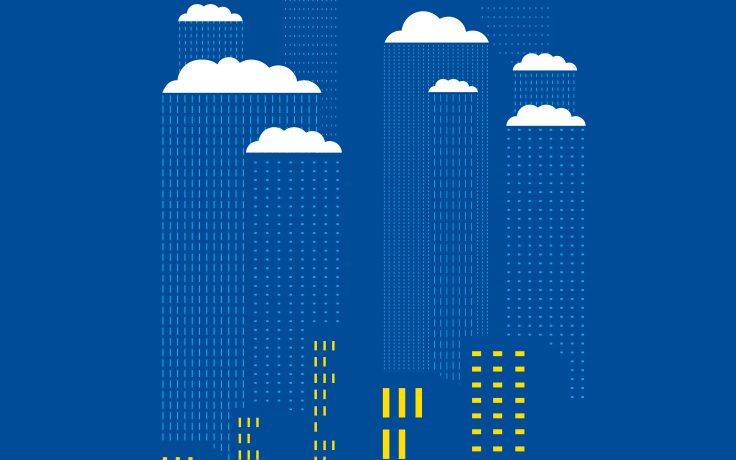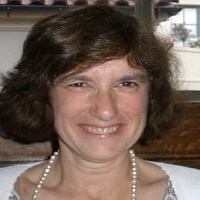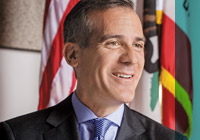WHEN YOU HEAR THE WORDS “CLIMATE CHANGE,” Alex Hall wants you to think of your grandchildren first, and only afterward about polar bears stranded on melting ice floes, or about flooding along the Florida coast.
Hall, a UCLA professor of atmospheric and oceanic sciences, said it will be the grandchildren of millennials who, by midcentury, will face many more extremely hot days in the Los Angeles Basin, along with more wildfires, a thinner snowpack in the Sierras and less water for the city.
He and his colleagues at the UCLA Institute of Environment and Sustainability can demonstrate how this will happen. Computer models from their two-year study, in collaboration with scientists at UC Irvine and elsewhere, have put numbers to free-floating concerns about climate warming and continued drought. Hall’s projections are sobering, even scary. But information is power, and his numbers create motivation. They show a path to achieve the ambitious sustainability goals that state and local policymakers have established to secure the future for your grandchildren — and theirs.
“These findings are of tremendous importance to the city and the region,” said Matt Petersen, chief sustainability officer for the City of Los Angeles. The UCLA research vividly describes the likely impact of increased heat, continued drought and extreme fire risk, Petersen said, and the models have already pushed city leaders and individual residents to respond.
Local climate models
Hall, 44, given to a close beard, a loose tie and an easy smile, credits three people with motivating him to study the atmosphere and the oceans: his father, a scientist; an inspiring undergraduate professor, who taught Hall at Pomona College; and ultimately the adviser for his doctoral dissertation at Princeton.
With funding largely from the U.S. Department of Energy, Hall and his associates have drawn from 30 existing models of the Earth’s climate and imposed their data on Los Angeles County under two scenarios. In the first, which he calls “business-as-usual,” lawmakers fail to make any significant changes between now and midcentury to limit greenhouse gas emissions. In the second, which he calls “mitigation,” world leaders act together to transform energy production to drastically reduce if not eliminate carbon emissions by 2041-2060. “Probably unrealistic,” he concedes, but the mitigation scenario offers an optimal benchmark.
Using 1981-2000 as a baseline, Hall and his collaborators focused on changes in four key climate elements: temperature, snowfall, wind and fire, and precipitation. Their modeling enabled them to predict changes in each of these atmospheric components down to the neighborhood level — in 2-kilometer grids. Nothing like this had been done before.
Under both business-as-usual and mitigation, Hall said, “Warming is inevitable.” During August, generally the hottest month in Southern California, average temperatures under business-as-usual will rise as much as 5 degrees Fahrenheit by midcentury, much higher than the hottest summers during the baseline period. Although August temperatures will not climb as high under the mitigation scenario, UCLA’s model shows that the L.A. region will still be hotter than in past summers.
But the number of extremely hot days — with temperatures of over 95 degrees — will spike dramatically under business-as-usual, particularly in the San Fernando and Santa Clarita Valleys — and even along the coast. Both central and coastal locations will see two to three times the number of extremely hot days. Higher elevations and inland areas will see three to five times the number of extremely hot days.
Warmer temperatures will cause precipitation to fall more often as rain than snow. Hall’s group predicts snowfall in the San Gabriel, San Bernardino and San Jacinto mountains will drop by half, resulting in drier, more combustible forests and lower water supplies.
Regional wind patterns will shift, bringing fire danger earlier. Historically, major blazes have occurred during October, when extremely dry desert air pushed westward toward the coast. But as the L.A. Basin warms in the coming years, there will be fewer such Santa Ana episodes in October and fewer fires fed by those winds. Instead, hotter temperatures will stoke more and larger blazes during July, August and September. An example is the 2009 Station Fire north of Los Angeles, which started in August. It charred 160,577 acres and resulted in the deaths of two firefighters. Researchers at UC Irvine predict that hotter conditions will cause an average of 130,000 acres to burn annually, almost double the current 76,000 acres.
Hall’s models see no significant change in the amount of precipitation in the region. But less snowfall and higher temperatures in local mountains will reduce stream flow, cause more evaporation and, ultimately, decrease the amount of mountain water available for municipal use.
Hall and his colleagues are completing a separate analysis focusing on the Sierra Nevada Mountains, the source of 60 percent of L.A.’s water. “We realized that we couldn’t tackle water use in Los Angeles in a holistic way unless we understand the regions where L.A. gets most of our water,” he said. Those results, soon to be published, worry him. The “remote water resources that we rely on are quite vulnerable,” he said. “There are pretty dramatic changes in store for the Sierras.”
Hall’s conclusion: “Adaptation is inevitable. We must respond to these changes.” That means relying more on local water sources and stepping up conservation and use of renewable water. Increasing conservation means redoubling individual efforts. It also means transforming the region’s water and power infrastructure to meet the challenges of a new age.
Los Angeles responds
City officials have taken this to heart. Last year, Los Angeles Mayor Eric Garcetti released the city’s first-ever Sustainable City plan, based in part on the UCLA findings. The plan establishes short- and long-term targets for water conservation and reuse. It calls for more reliance on solar power; better energy efficiency in appliances as well as in homes and commercial buildings; and reductions in greenhouse gas emissions. For example, the L.A. plan calls for cutting per capita use of potable water 20 percent by next year 2017, a goal the city is close to reaching. The plan also calls for decreasing the city’s purchase of imported water by half in another nine years.
These are daunting but achievable goals, said Nancy Sutley, chief sustainability officer for the Los Angeles Department of Water and Power. “Much of the city’s future planning is based on demographic projections,” she said. Hall’s work has demonstrated that “we have to add in this third element: What is the climate going to be like and what will its impact be?”
The DWP has long offered a smorgasbord of rebates and incentives to nudge residents and businesses toward water and energy conservation — for example, by landscaping with drought-tolerant vegetation, planting more trees, capturing rainfall, installing solar panels, buying electric vehicles and upgrading to more efficient air conditioning units, LED light bulbs and more effective insulation.
The UCLA research also is “incredibly important in terms of the investments we make in infrastructure and services,” Sutley said. The DWP is building and retrofitting facilities “that we expect to be functioning in 50 years,” she said. While the region’s existing power and water infrastructure was constructed during an era of reliable rains and Sierra snowpack, future facilities must anticipate an increasingly hotter and drier climate.
To cut its reliance on imported water, DWP is developing more local supplies. It is spending hundreds of millions of dollars, for example, to capture and treat rainwater underground in the massive San Fernando Valley Groundwater Basin. Water that once ran down sewers and out to sea will be stored and recycled for a variety of uses, including to supplement the city’s drinking water supply. Orange County has successfully recycled local brownwater for about a decade, but Los Angeles has been slower to take this step.
On the power side, the DWP recently completed its divestiture from the Navajo Generating Station in Arizona, decreasing the department’s coal-generated electricity by 25 percent. The move represents a major step toward the utility’s goal of eliminating coal from the city’s power portfolio by 2025.
Moreover, by 2029, the DWP says it will replace an ocean-water cooling system at its Scattergood Generating Station with air cooling equipment, further reducing the city’s greenhouse gas emissions and better protecting marine habitats.
‘Total game changer’
Regionally, the Metropolitan Water District, which supplies just over half of L.A.’s water, is working with the L.A. County Sanitation District to build a next-generation advanced treatment project in Carson that will recycle and store wastewater clean enough to drink. This plant could be “a total game changer” for local water supplies, said Mark Gold, who oversees UCLA’s Sustainable L.A. Grand Challenge.
The Grand Challenge links researchers from several disciplines to develop technologies, strategies and policies to address major problems that impact the region and beyond. It aims high: to transition Los Angeles to 100 percent renewable energy, 100 percent locally sourced water and enhanced ecosystem health by 2050.
Health officials in cities throughout the county are working with Hall and his team to help elderly and low-income residents tolerate hotter temperatures — for example, by increasing the number of cooling centers in malls, libraries and community centers, where people without air conditioning can go during heat waves.
It is important to increase public awareness, said Angelo Bellomo, deputy director of health protection at the Los Angeles County Department of Public Health. Climate change is “not a hopeless problem,” Bellomo said. “There are things that individuals can do.” Hall’s fine-grained heat projections, he said, encourage the county and local municipalities to plan ahead, each according to its own conditions — which will differ, for instance, from Glendale to Canoga Park to Santa Monica.
Hall makes the same case. “A lightbulb goes off when people see this work, because it informs them about what climate change will do to their own neighborhood,” he said. “It changes discussion from polar bears and global mean temperatures to something much more local and much more meaningful.”
Roles for everyone to play
Every person is important in L.A.’s response to climate change. Since arriving at UCLA in 2001, Hall has become an enthusiastic “dry gardener.” He landscapes his Miracle Mile home with native plants and has installed gutters and rain barrels to capture rainwater. That kind of change is crucial. “We use more than half of our water,” he said, “to irrigate plants that are not appropriate to this climate on life support.”
He also tries to minimize his driving; on most days Hall commutes to Westwood by bus or on his Brompton folding bike.
The changes he has made in his own life make him optimistic about responding to the warmer climate his modeling foresees. “The hope with this type of project is that it makes the conversation about practical things — how do we cope with twice as many severe hot days in a certain locale?
“That is not valuating,” he said. “It’s just a problem that needs a solution.”
It’s a much easier conversation, he said, than wrestling with “deeper questions about how prosperous should we expect to be, or how many resources we have a right to consume.”

























